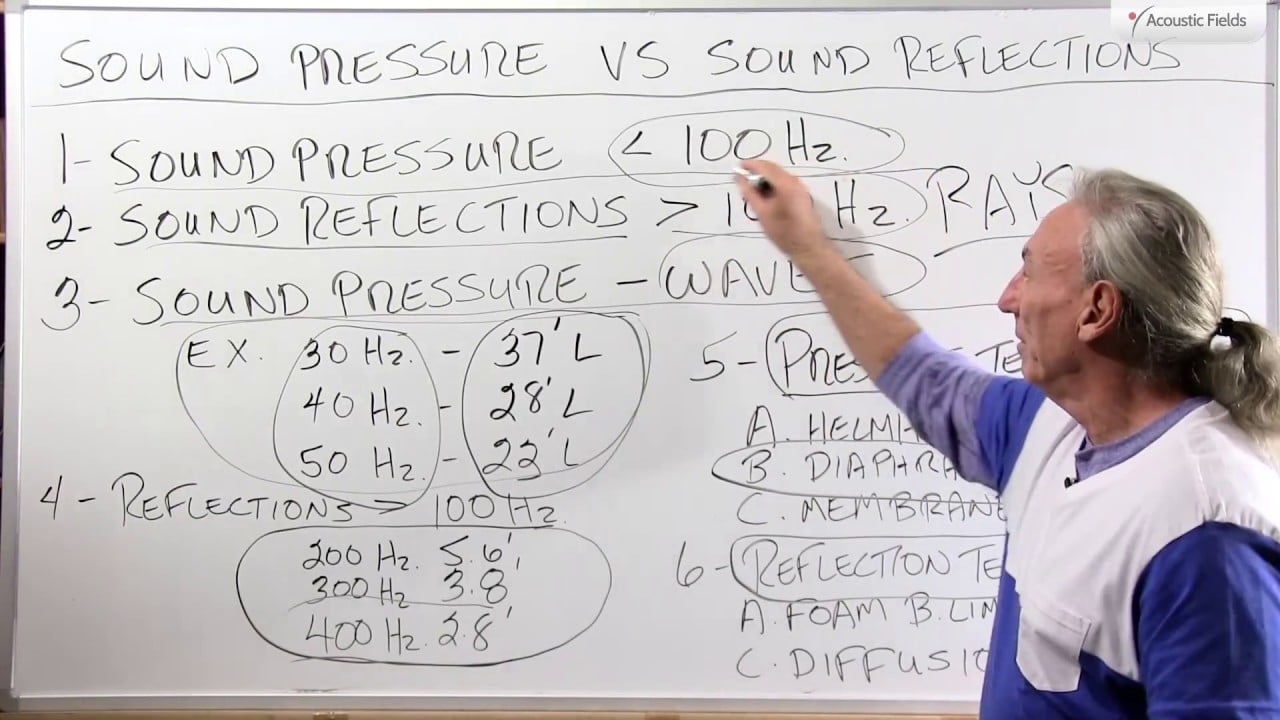We need to distinguish between sound pressure and sound reflections because a lot of people mix these two concepts and terms up so let’s walk through some definitions. Sound pressure is wave energy so it’s like the ocean, oscillating wave after oscillating wave. Now what distinguish pressure from reflection are the length, height and width of those waves so their pressure activated Sound Ocean waves roll and oscillate to the shore and then diminish.
So it’s a wave and the energy is energy that’s below 100 cycles so that’s a good definition of pressure, anything below 100 cycles we’re going to consider in the realm of a small room acoustics as pressure. Reflections on the other hand would be energy that’s above 100 cycles so that would be rays, like sunshine so they’re shorter in distance, smaller, not as thick, so those are your two general categories of energy that we deal with in acoustics.
Let’s take a look at some of those waves and their lengths: thirty cycle wave thirty -seven foot long, forty cycle wave – twenty eight foot and a 50 Hertz wave is twenty-three foot long so think of these dimensions and match them with the frequency and then when you come up with an issue say alright I have a forty cycle problem in my room, I know the energy that’s causing that problem is twenty eight foot long in each sequence so what am I going to use to deal with that? Am I going to put a curtain up to stop something twenty eight foot in length? No, so I don’t tell people to use common sense a lot in acoustics because what’s common for one person may not be sensible for another so the bottom line is look at the length of the energy you’re dealing with and then just say to yourself is a curtain going to be able to stop something 37 foot long? Probably not so we’re going to have to use other devices to do that.
Reflections on the other hand is energy that’s above 100 cycles so if we look at a 200 Hertz wave or ray, 5.6 foot long, smaller okay can a curtain deal with that? Probably, smaller energy, not as long so we can manage it that way. 300 cycles, 3.8 feet, 400 cycles 2.8 feet and as we go up they go smaller a thousand cycles, a thousand Hz is about a foot long. So how do we treat those? Pressure technologies and here’s where the confusion lies in the treatment, I think people kind of understand the definition but it’s the treatment. Any energy below 100 cycles and is a pressure activated technology needs to be treated with pressure activated devices so Helmholtz, diaphragmatic and membrane and we’ve done countless videos on those so we won’t go into it but these are pressure activated device. This is the one we favor (diaphragmatic) because it’s the most powerful; it’s also one of the most difficult to get right. So Helmholtz, we all know that is more frequency specific and I’m going to do a video on Helmholtz so you get an idea of that. Membrane is a cousin to diaphragmatic and we can talk about that later.
Now reflection technologies, energy above 100 cycles that’s ray oriented. foam is good, limp mass, curtains, things like that building insulation and diffusion, don’t forget about diffusion because diffusion will reduce the impact and spread it out more evenly and cause less of an issue, cause less of a reflection if you will from the room boundary surface. So there’s a little background on sound pressure versus sound reflection.
—
This is an unedited transcript from our video series from Acoustic Fields. There will be some errors in grammar and sentence structure that occur during this translation process.
For complete understanding and comprehension, please view the video which is included in this text. For any additional information regarding this topic or others relating to room acoustics, please contact us directly at:
P: 520 – 392 – 9486








Hi, Dennis et al,
Unsure if this note is on topic,
Question…do I sum rooms volumes when they are open to each other, shared ceilings and some walls , different floor covering?
My small apt has a living room which is open to the dining area and 80% open to the kitchen, lseparated by 3 ft high counterLR and DA share a wall. counter, sink.
LR and dining area share floor but LR is varpeted
. LR , kitchen and dning area share 8 foot ceiling.For my room annalysis form, I focus only on living room but reflections will go much further in some directions, while bass freqs pressures will be spread amongst all, I suslect.
Example – bedroom w a large open closet or bath w door always open, etc.
Any guidelines or rules of thumb ?
Thanks for anything and patient consideration.
steve t in CA
S, Dual usage living/listening are very difficult because the acoustical treatment needs will intrude into your living space. The best way for me to approach this is for you to tell me what areas of the wall you will be willing to treat. Treatment on wall surfaces will cover 50 % of most surface areas. Floor standing units will be required to manage the low frequencies. I will need available space.